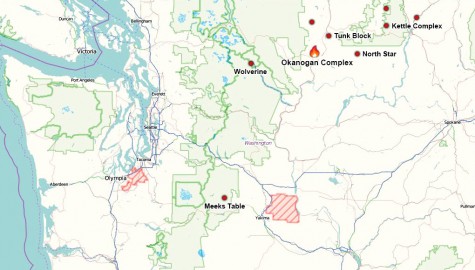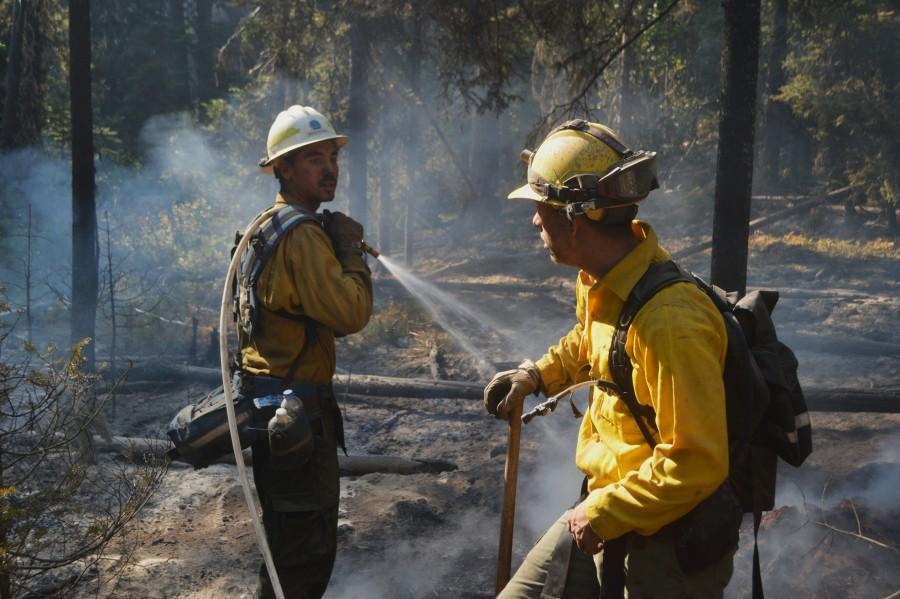Historic fire season leads to millions in damage
Courtesy of Department of Natural Resources
Firefighters mop up the Okanogan Complex by extinguishing burning and hazardous material.
October 7, 2015
When Katie Brown started her workday in Ellensburg in mid-August, she had no idea the largest wildfire in state history would soon threaten her childhood home in Okanogan, Wash.
“I was not home when the fire started threatening my home…which is the worst feeling. Knowing my family is stressed and not being around to help,” said Brown, a 2015 graduate of Central.
Brown’s family home sits on eight acres of mostly undeveloped sagebrush and grass. She said a group of five volunteers came to her house to dig fire lines and clear brush from around the structure with a bulldozer.
She said her family was told to soak the exterior of the house with water and pack up any valuables.
“My family evacuated for one night,” Brown said. “We live on a hill about five miles out of town with only one way down. When the fire started to travel up the driveway, it was either stay and fight, or run the risk of being trapped in a dangerous situation.”
In the end, the Brown home was undamaged, but only by a small margin.
“Everything outside the fire line was toast,” Brown said. “It looked a little bit like the world had ended and my house was this little oasis in the middle.”
The Browns were fortunate. The Okanogan Complex fire, which was caused by a lightning strike on Aug. 14, ultimately damaged or destroyed 120 homes and caused an estimated $45 million in damages.
According to the Northwest Coordination Center, which monitors wildfire activity in the region, the fire consumed 133,420 acres and required 442 fire personnel to finally bring it under control.
Among those who fought the fire was Captain Joe Delvo of the Kittitas Valley Fire and Rescue. He was in charge of a task force of seven brush trucks from various districts with two 3,000-gallon water-tenders to supply the brush trucks with water.
According to Delvo, the task force team spent 14 days out in the complex working to protect homes and structures in front of the fire.
“There’s definitely been a change, we’ve had a growing trend for the last four to five years of these large, catastrophic fires,” Delvo said. “This is my 30th season fighting wildland fires and the last four or five years we’ve seen fires grow at unprecedented levels.”
Jacob Gann, a junior clinical psychology major at Central and a medic with the Washington National Guard, found himself called to fight the fire on Aug. 16.
Gann said his guard unit largely assisted the civilian fire crews who did much of the firefighting. Additionally, they dug fire trenches around buildings and even saved a small structure and a recreational vehicle generator.
“The civilian firefighters took on most of the burden,” Gann said. “They were at the front of the fire and they kept the guard relatively safe. We only treated one patient and it was nothing serious.”
Gann said the biggest surprise was seeing how the fire crews went about protecting the structures.
“I hadn’t realized the Department of Natural Resources actually had a tactic for saving homes from the fire,” he said. “They would bring out large industrial sheets of tinfoil, stapling them around the houses.”
The Okanogan Complex fire, now mostly contained, created air quality issues throughout Central Washington and Ellensburg during much of mid to late August.
The CWU Student Medical & Counseling Clinic responded to the fires by providing masks and respirators at no cost to students. Additionally, the clinic assisted a handful of students who came in with issues such as breathing difficulties due to the poor air quality.
“We had boxes and boxes of respirators,” said Chris De Villeneuve, executive director of Central’s Student Medical & Counseling Clinic. “The N95 masks help filter out particulates, that was all provided for free.”
De Villeneuve said the clinic worked with the university to monitor the fire status and provide any necessary support to the students who were on campus during the summer.
Additionally, the clinic put out health warnings on Central’s website to alert the community of the danger of working outdoors during August. The masks were also offered to students, faculty and staff at the SURC.
“Right now, the particulate rates are pretty low, so it’s not a major health concern,” De Villeneuve said. “But it’s one we continue to monitor and if something comes up, then we make sure we work with the university on having a statement that goes out notifying everyone on campus and in the community and the reservation.”
During the peak of the wildfire, Central posted regular wildfire and air quality updates on a special web page (http://www.cwu.edu/fireupdate), as did the Northwest Interagency Coordination Center (http://gacc.nifc.gov/nwcc).
While the final impact of the Okanogan Complex fire won’t be known for a while, Katie Brown and her family, like many others who escaped the worst of the wildfires, are just thankful they were spared.
“Knowing your family home could burn and not being able to come home and help is really a terrible feeling. Even if I had gone home, there’s not much I can do against Mother Nature,” Brown said.
“I have a few friends who lost homes and farms that had been in the family for generations,” she added. “My family was truly lucky, and I believe those firefighters who came up to the house are the reason my home is still standing.”



